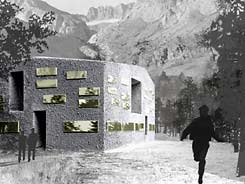 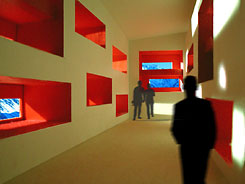 The winning design, by the Swiss design firm Berrel Architekten, featured sleeping and other functional spaces embedded in the walls. |
UC Berkeley Web Feature
Mountain hut design contest draws avalanche of entries
BERKELEY – Designs for a prototype wilderness base camp in the Sierra flooded in from around the world to a competition co-sponsored by UC Berkeley’s College of Environmental Design, and are now on exhibit at Wurster Hall.
In addition to the winning design by a team of Swiss architects, about 150 of the more than 400 proposals submitted by designers in more than 35 countries are on display.
The Palisades Glacier Mountain Hut Competition, which was judged on Dec. 15, was sponsored by the College of Environmental Design and the Wiener Family Fund for Public Architecture and Landscape.
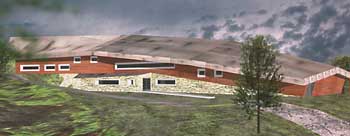 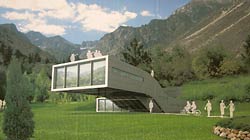 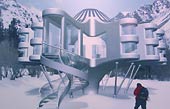 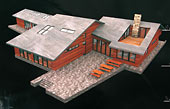 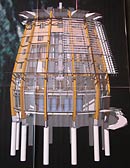 Designs covered the spectrum from classic and rustic to modern and even futuristic.  |
The goal was to produce a new concept for the mountain hut, a relatively large structure that typically features shared sleeping and toilet facilities. The mountain hut is common in Europe, but not in the United States, where tent camping is the preferred wilderness accommodation.
Sponsors were looking for designs incorporating technological solutions to resource consumption and pollution, while maintaining a strong wilderness experience for 60 to 80 people using the hut.
Harrison Fraker, dean of the college, said he anticipated the resounding response to the competition because of its intriguing challenge of developing a design that is site specific and yet prototypical, and because of growing interest in environmental aspects of design.
The project site — where the Swiss team’s structure will be built — is near the trailhead leading to the mile-long Palisade Glacier in Central California, the largest glacier in the Sierra. The anticipated project budget is about $1.5 million.
Clients are the non-profit David Brower Memorial Mountain Hut at the Palisades Glacier Foundation and the U.S. Forest Service. Construction is expected to begin in June 2004.
The contest was open to licensed architects, landscape architects, engineers, designers and students.
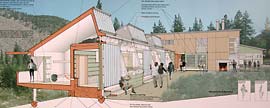 Honorable mention designs included one by a team from Oakland (above), and another resembling a giant tent. 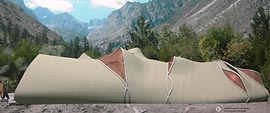 |
The design by the Swiss team that took first place and a $15,000 prize features innovative communal sleeping arrangements in the form of three box-like structures, and a “super insulation” strategy that does not rely strictly on solar heat gain.
Two teams from New York City, one from Oakland and another from Alexandria, Va., received honorable mentions, and each was awarded $2,500. Each team included members who are alumni of the College of Environmental Design.
The mountain hut competition was the first in a series. No date or topic has been chosen yet for the next event.
“The competitions are really trying to increase the focus and exploration of sustainable issues and all types of building challenges,” said Fraker.
"As a native of Mississippi, a state wherein the sense of place is perhaps at its apogee in America, I am keenly aware of how place defines people,” said Wiener. “California has a spectacular landscape as one of its hallmarks. Yet the built environment is frequently unequal to our natural landscape.
"The purpose of the mountain hut competition was to reconsider the relationship between what fortune has bestowed upon us and what is constructed on the land. Arguably the strongest attribute of the competition was its bringing trophy architecture to the back country, where it is most needed, and liberating such design from being the privilege of urban centers,” Wiener continued. “One hopes that the effort commences a trend toward buildings which complement -- rather than detract -- from the geography which makes California so extraordinary."
The mountain hut design entries will be on display at Wurster Hall through January. An online gallery of more submissions will be posted by the end of January and will include jury comments about the winning entries. The Website is www.ced.berkeley.edu/competitions.
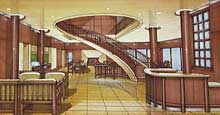 |
Interior designs also covered a broad range of styles. | 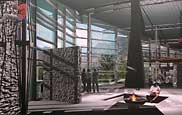 |

